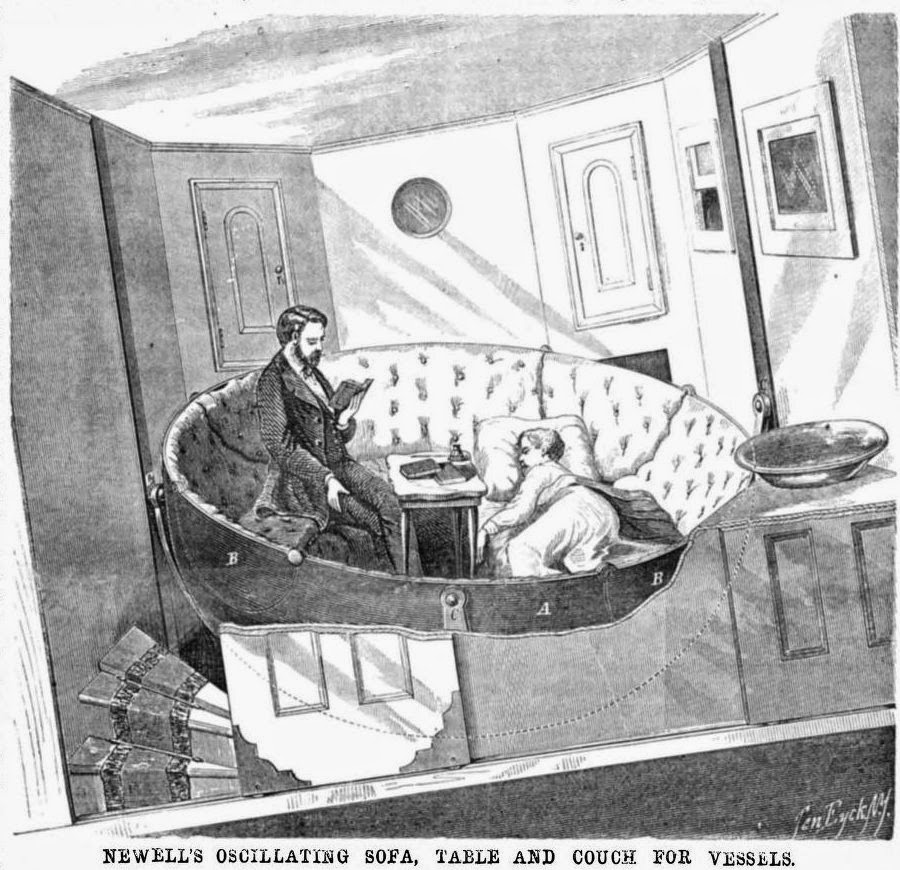- Stephen French Whitman, Children of Hope: A Novel (1916)
The protagonist of Children of Hope, or at least the author, seems to be way behind the times, as this idea had been tried, tested and discarded decades previously. I've returned to it because of a loose end to the 2008 Bessemer Saloon and other experimental ships, which has been one of the most popular posts on JSBlog. Aside from Sir Henry Bessemer's early-1870s experiment with an 'swinging saloon' supposed to stay level as the ship rocked, there are a few references to other ship lines trying it, notably White Star.
In the same direction, on a larger scale, are the very complete and ingenious oscillating berths, already introduced to a limited extent on some of the transatlantic steamers, and no doubt destined, in one form or another, to become almost universal on lines that bid for popular favor. These berths have now been brought to a state of perfection that would seem to make it possible for the poorest of sailors at least to enjoy undisturbed rest so long as he or she can keep his eyes shut. The oscillating arrangement is adapted to respond either to pitching or rolling, and it will certainly mitigate, if it does not altogether do away with, the horrors of the North Atlantic passage.There are accounts with specifics of the ships and the technology.
- John W Ryckman, Report of the International Maritime Exhibition, Boston 1889-90, Rockwell and Churchill, 1890
The Britannic, a new steamer belonging to the White Star Line ... The interior fittings of the ship are remarkable for elegance and completeness, no improvement adding to the personal comfort of passengers being omitted. There is a blowing engine to force fresh air through the cabins, swinging berths for the sea sick, and running water and basins in every state room.Scientific American has a nice artist's impression and description of the Newell concept, that was patented on April 5, 1870, by Lorenzo D Newell of 514 Broadway, New York (see Improvement in marine furniture US 101495 A):
- Scientific American, Volume 31, July 25 1874, page 56
It is not astonishing to find that the White Star vessels are particular favourites among the Americans ... In addition, it should be mentioned that some of the ships have Newall's [sic] patent swinging berths, which are suspended upon the same principle as Mr. Bessemer's celebrated saloon in the vessel constructed for the passage between Dover and Calais
- The Nautical Magazine, Volume 45, 1876, page 321
 |
| Newell's oscillating sofa, table and couch for vessels from Scientific American, Vol. XXII, No.21, May 21, 1870. |
Later accounts, however, explain that the technology wasn't a success.
Another White Star experiment was with the oscillating saloon, intended to keep berths and staterooms level while the ship was rolling, but this was no more a success on the broad Atlantic than it was on the English Channel when tried in the steamer Bessemer.
- RA Fletcher, Steam-ships: The Story of Their Development to the Present Day, J.B. Lippincott Company, 1910
 |
| Newell's patent diagram |
Meanwhile, there are a number of examples of patents and accounts of similar devices on other ships. Mr Newell wasn't the only inventor with ideas in this direction. The idea went under various names, such as "oscillating berths" (as in patent , US 141614 A by B Weisker in 1873, and US 140014 A by IA Chomel, also in 1873, and US224232 A by Theodore OL Schrader in 1880) or "self-levelling berth" (as in US 222050 A by David Huston in 1879, US 228100 A by W Miller in 1880, and Canada Patent 13874 by James H Porter in 1881).
 |
| Australian Town and Country Journal (Sydney, NSW: 1870 - 1907) Saturday 16 June 1888, page 33 via Trove |
The image left, from Australian Town and Country Journal (Sydney, NSW: 1870 - 1907), Saturday 16 June 1888, page 33, shows a Brunswick berth; the accompanying article says that these were in use on steamers of the Inman and North German lines.
An account in the Otago Witness, 1881, provides a testimonial for the "Huston" berth:
The inventor has received numerous testimonials from persons expressing gratitude for the relief afforded. Among them is one from a private gentleman who recently took passage from Rio de Janeiro to New York in the steamship City of Paris. The writer, it would appear, had heard of the "Huston" berth, but bad some doubts about its efficiency. His scepticism was dispelled, for he writes, "This is a large steamer of 3,500 tons, handsomely fitted, and plenty of ice for cooling drinks. We have two cabins adjoining, and, strange to say, they are both fitted with Huston's patent berths, in which we feel very comfortable as the motion is scarcely perceptible."Scientific American for February 19th 1881 (page 115) has a picture of the Houston berth, noting it to have been in action aboard the City of Alexandria, "plying between this city and Havana" - but also noting that "several steamship companies have tried and abandoned such devices". Nevertheless, the idea was still being tried in the 1920s, as described in Popular Mechanics.
- Scientific notes, Otago Witness, Issue 1533, 26 March 1881, Page 8
 |
| Popular Mechanics, Aug 1921, page 202 |
Rocked in the cradle of the deep,- Ray
I calmly rest and soundly sleep.
- Emma Hart Willard (via Bartleby)


No comments:
Post a Comment